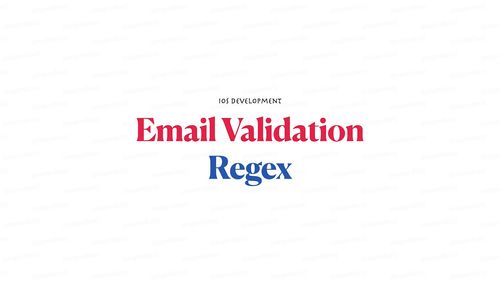Email addresses are ubiquitous in today's digital world, serving as our virtual identities. Ensuring the accuracy and validity of these email addresses is crucial in various applications, from web forms to user registrations. This is where regular expressions (regex) come into play. In this comprehensive guide, we'll explore the world of email validation rules using regex. By the end, you'll possess the knowledge and skills to craft regex patterns that effectively validate email addresses, no matter how complex the rules.
Why Regex Email Validation Rules Matter
Before diving into the intricacies of regex for email validation, let's understand why email validation rules are essential:
Data Integrity: Valid email addresses ensure clean and accurate data in your applications, reducing errors and improving user experience.
User Experience: Properly validated email addresses enhance the user journey, from registration to communication and account recovery.
Security: Validating email addresses is a critical part of safeguarding your application against malicious activities and spam.
Now, let's embark on the journey of crafting regex email validation rules.
Understanding Regular Expressions (Regex)
Regex is a powerful tool for pattern matching and validation. In the context of email validation, regex allows you to define a pattern that an email address must adhere to. Here's a basic regex pattern for email validation:
^[a-zA-Z0-9._%+-]+@[a-zA-Z0-9.-]+\.[a-zA-Z]{2,}$
This regex pattern checks if the email address contains alphanumeric characters, along with common email symbols like @, ., -, _, and %, followed by a domain with at least two letters.
Components of Email Validation Rules
To create effective regex email validation rules, consider the following components:
Local Part: The local part of an email address (e.g., username) can include alphanumeric characters and special characters like . and -.
@ Symbol: The email address must contain the @ symbol.
Domain: The domain part should include the domain name (e.g., "example") and a top-level domain (TLD) like ".com." The domain name can include alphanumeric characters and hyphens.
TLD: The TLD should consist of two or more letters.
Now, let's explore some advanced regex patterns for specific email validation rules.
Advanced Email Validation Rules Using Regex
Allowing Subdomains: To validate email addresses with subdomains, modify the regex pattern like this:
^[a-zA-Z0-9._%+-]+@[a-zA-Z0-9.-]+\.[a-zA-Z]{2,}(?:\.[a-zA-Z]{2,})?$
This pattern allows subdomains, making email addresses like "[email protected]" valid.
International Characters: To validate email addresses with international characters, consider the following regex pattern:
^[a-zA-Z0-9._%+-]+@[a-zA-Z0-9.-]+\.[a-zA-Z]{2,}(?:\.[\p{L}]{2,})?$
This pattern allows international characters in the domain and TLD.
Implementing Email Validation Rules Using Regex
To implement email validation using regex in your application, follow these steps:
Choose or Create a Regex Pattern: Select a suitable regex pattern or create one based on your specific email validation rules.
Integrate with Your Application: Incorporate the regex pattern into your application's validation logic. This can be done using programming languages like JavaScript, Python, C#, or any language that supports regex.
Test Extensively: Test your email validation rules rigorously to ensure they work as expected. Check for edge cases and various email formats to guarantee accuracy.
Handle Validation Errors: When an email address doesn't match the regex pattern, provide clear error messages to users, indicating why their input is invalid.
Commonly Asked Questions About Regex Email Validation Rules
1. Are regex patterns case-sensitive for email validation?
- Regex patterns are case-insensitive by default. You can make them case-sensitive by specifying options in the pattern.
2. Can regex validate email uniqueness?
- No, regex is for format validation only. To validate email uniqueness, you'll need server-side logic and database queries.
3. How can I validate email addresses in multiple programming languages?
- Most programming languages offer regex support. Simply adapt the regex pattern to the language you're using.
4. What's the best regex pattern for validating international email addresses?
- Use a pattern that allows international characters in the domain and TLD, as shown in the advanced example above.
5. Are there online tools to test regex patterns for email validation?
- Yes, various online regex testers allow you to experiment and validate your patterns.
In conclusion, mastering email validation rules using regex is a powerful skill that can enhance your applications' data quality, user experience, and security. Whether you need to validate basic email addresses or complex international ones, regex empowers you to craft patterns tailored to your specific requirements. Start creating robust email validation rules with regex today and elevate the quality of your applications!



